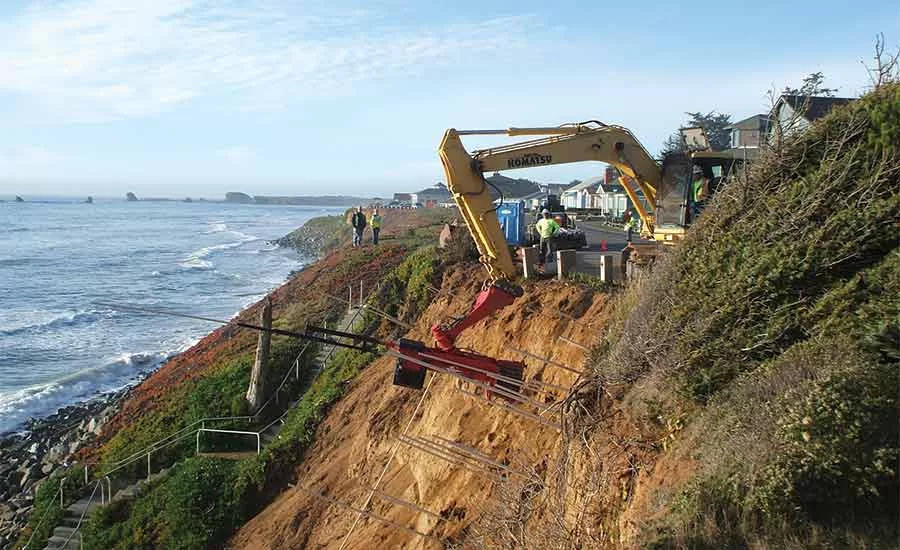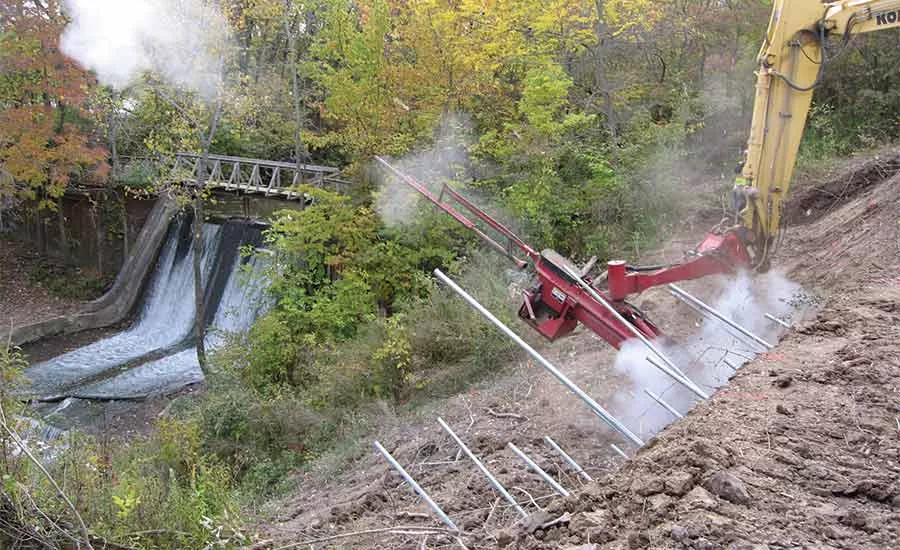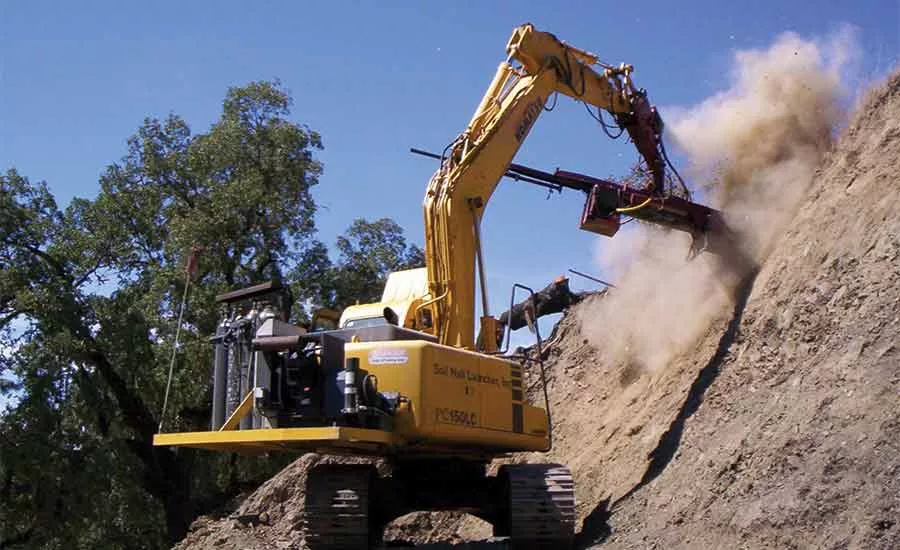Soil Nail Launcher Wins Innovative DFI Award

The Soil Nail Launcher, a repurposed wartime cannon, adds to the options for stabilizing landslides.
Source: Colby Barrett, CEO, photos


The launcher, created by Al Ruckman, PE, and Robert “Bob” Barrett, PG, won the C. William Bermingham Award from the DFI.
Each year, the Deep Foundations Institute (DFI) showcases and celebrates important achievements and contributions by individuals, teams and companies to the deep foundations industry.
One award in particular distinguishes the innovative spirit of one of the foundation’s past presidents. The C. William Bermingham Innovation Award, established in 2012 to honor Bill Bermingham and his contributions, encourages and recognizes unique and innovative offerings to the deep foundations industry.
The criteria for the award include, “contributing to the advancement of the deep foundations industry by introducing a new and unique practice including means and methods, design procedures, equipment and materials by an individual, a team or a company.” The award recipient receives $5,000.
This year’s C. William Bermingham Award winner is the Soil Nail Launcher. The award is expected to be presented at the DFI’s 43rd Annual Conference on Deep Foundations in Anaheim, Calif., held Oct. 24-27. The launcher was created by Al Ruckman, PE, and Robert “Bob” Barrett, PG, founders of GeoStabilization International, a leading geohazard mitigation firm operating throughout the U.S., Canada and New Zealand.
The Soil Nail Launcher is a compressed air cannon that’s used to repair shallow slope instabilities at a fraction of the time and cost of traditional technologies. According to Barrett, it can accelerate a 1.5-inch diameter, 20-foot long steel or fiberglass tube to 250-miles per hour in a single shot. The rapid installation process results in a variety of benefits over conventional nailing techniques.
National Driller was able to speak with Barrett about the Soil Nail Launcher, as well as his thoughts on winning the Bermingham Award.
Q. Who are you, and why would readers want to hear from you?
A. I’ve been in this industry for over 52 years. I earned a degree in geology from Marshall University, then worked for the West Virginia DOH and the Colorado DOT for over 30 years as a landslide specialist. I was also the chief geologist for design and construction of Interstate 70 across the Colorado Rockies. I was the manager of geotechnical research for the Colorado DOT and for the Colorado Transportation Institute, and a co-inventor of the Colorado Rockfall Simulation Program (CRSP).
My strongest area is geotechnical research and, together with Al, hold eight patents for soil stabilization and rockfall mitigation devices, as well as Geosynthetically Confined Soil (GCS) retaining wall innovations, earthquake wings for bridges, scour micropiles for open bottom boxes and other applications.
I received the 1991 Colorado Governor’s award for Creativity and Innovation in Government Service. Al and I were the recipients of the 1998 IFAI design award for design and construction of a 55-foot high GCS retaining wall in Grand County, Colo. I was the first chair of the TRB Committee on Geosynthetics from 1990-97. In 2009, Mike Adams (FHWA) and I were the recipients of the NOVA award for our innovations with GCS.
Al and I have presented technology transfer programs on five continents covering GCS, landslide mitigation and rockfall control, and we’ve constructed GCS walls and abutments across the globe. Our largest is in Turkey and the most complex is in Jamaica. We founded the Soil Nail Launcher company (predecessor to GeoStabilization International) in 2001.
Today, I am working mostly on gaining wider acceptance of GCS technologies for bridge abutments and piers.
Q. What are your thoughts on receiving the C. William Bermingham Award?
A. I was surprised and flattered. We never considered working for recognition like this. We just did our best to create newer tools and technologies. There are great personal rewards for those successes, [and] it is humbling when those efforts are singled out by this prestigious group.
Q. What is the Soil Nail Launcher? How does it work and what problem does it solve?
A. The [Soil Nail] Launcher is actually a wartime cannon. It was developed by the British military to launch nerve gas canisters. Upon retirement, it was repurposed to send steel bars into the ground. It can accelerate a 100-pound, 20-foot long solid steel bar to over 200-mph in an 18-inch barrel. These projectiles enter the earth so fast that the soil particles seem to “jump away” from the tip, creating a frictionless entry. When the bar comes to rest, the soil engages the bar with a very high bond strength. This does not happen with driven bars.
We have used it to stabilize landslides via the added resisting forces imparted by the bond between the soil and steel bar, and, when we use hollow tube nails, we can simultaneously provide drainage routes for groundwater. We can shoot them at steep angles and improve bearing capacity. We can install them in close arrays to prevent or mitigate scour. We can use the hollow nails to drain methane in landfills. We are currently installing hollow nails on bridge abutments in the Northwest Territories to allow deeper frost penetration in the winter months.
Q. What advantages does it have over previous ways slope instabilities were approached?
A. The cannon adds to our options for stabilizing landslides. Traditional measures that also work well include removing material from the top (reducing driving forces) and/or adding material at the bottom (increasing resisting forces). More recently, designers included driven or drilled piling within the area of the slide to increase resisting forces. Even more recently, researchers developed the concept of placing steel bars (soil nails) nearly horizontally in the top area of the slide. This adds to the resisting forces in a novel way. (Another good choice is moving the facility or roadway onto stable ground.)
Each come with costs and other limitations. Physically moving material is often limited by environmental and logistical constraints and by rights of way issues. Driven and drilled piling can be limited by cost, by overhead utilities, by working space for that large equipment and by the relatively long time for completion. Soil nails are difficult to install in actively moving slides and take time to mobilize and complete.
The Soil Nail Launcher offers the quickest and least expensive option for correcting smaller slides in fine grained soils … and slides are more likely in fine grained clays and silts. We have completed projects in less than a day, including mobilization. It is not constrained by rights of way or overhead utilities. The speed of installation allows us to close narrow roads and railroads for a few minutes at a time and dash in and out between openings to install the nails. And those nails are immediately effective — no waiting for grout to set. In these niches, this is a welcome addition to our suite of options.
Q. Who would use a technology like this?
A. Anyone with slope stability issues … highways, rail, utilities, gas, oil, private homeowners. [There’s a] long list. [Even] counties, townships, state, federal, USFS, NPS, [etc.]
Q. What is GeoStabilization International, and what does it do?
A. We founded our company as Soil Nail Launcher Inc., and as we grew to offer more solutions that weren’t just the cannon, we changed our name to GSI to reflect this growth. We pride ourselves in offering a complete investigation, design, construction and warranty option for almost any geotechnical problem. Our core values include always working in the client’s best interests, and that includes bringing leading edge tools and technologies to every project.
Looking for a reprint of this article?
From high-res PDFs to custom plaques, order your copy today!





